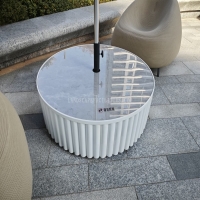Welcome to the website for landscape facilities products and knowledge.
How does the table’s design address concerns about interference with local wildlife corridors?
In modern furniture design, the intersection of functionality and environmental responsibility has become increasingly crucial, particularly when addressing concerns about wildlife corridor disruption. The fundamental challenge lies in creating tables that serve human needs while maintaining ecological connectivity for local fauna. Through strategic design approaches, furniture makers can significantly reduce their impact on animal migration routes and habitat connectivity.
The primary consideration involves material selection. Designers now prioritize sustainably sourced wood from managed forests where wildlife corridors are preserved, or alternatively use reclaimed materials that require no new habitat disruption. The processing methods further enhance this ecological approach, with manufacturers employing techniques that minimize chemical treatments which could leach into surrounding ecosystems. The table's structural design itself plays a pivotal role in wildlife preservation. Elevated designs with slender, widely spaced legs create minimal ground disturbance, allowing small animals to pass underneath unimpeded. This approach maintains the natural pathways crucial for species like amphibians, reptiles, and small mammals that rely on continuous ground-level connectivity.
The installation process represents another critical factor. Thoughtful designers specify ground-level preparation methods that avoid extensive digging or soil compaction, which can permanently alter subterranean pathways and root systems. Instead, they recommend minimal foundation work that preserves the natural topography and drainage patterns essential for local ecology. Some innovative designs even incorporate habitat features directly into the table structure, such as integrating native planting spaces within the base or using textured surfaces that provide temporary resting spots for insects and small creatures.
Beyond physical structure, the manufacturing philosophy extends to the entire product lifecycle. Tables designed with disassembly in mind reduce the need for heavy machinery during installation or removal, thereby decreasing soil compression and vegetation damage. This modular approach also allows for repairs and part replacements rather than complete disposal, minimizing waste that could potentially obstruct wildlife movement if improperly discarded in natural areas.
The location planning for table placement demonstrates another layer of ecological consideration. Designers often collaborate with landscape ecologists to identify optimal positions that avoid known wildlife thoroughfares or seasonal migration paths. This proactive assessment ensures that the final installation doesn't create barriers where animals traditionally move between feeding areas, water sources, and nesting sites. The height calculation similarly reflects this mindfulness, with designers carefully balancing human ergonomics with the preservation of aerial pathways for birds and arboreal species.
Through these multifaceted approaches, table design evolves from merely fulfilling utilitarian purposes to actively participating in habitat conservation. The resulting pieces demonstrate that human furniture and wildlife movement need not be mutually exclusive, but can coexist through thoughtful planning and ecological awareness. This harmonious integration represents the future of responsible design, where every created object considers its place within the broader environmental context and contributes positively to ecosystem health.
Related search:

Recommendation
Round metal tube border design table with tempered glass or granite countertop on the top.